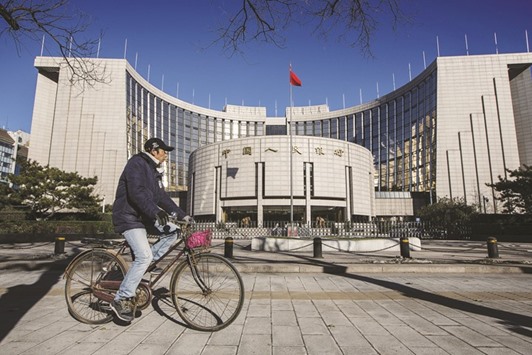China is set to report its weakest full-year growth figure in 25 years tomorrow on the back of slowing output and sagging investments, troubling news that will likely dominate discussion at the European Central Bank and Bank of Canada policy meetings.
Economists said the expansion of the Chinese economy was held back by sluggish domestic and external demand, weak investments, factory overcapacity and high property inventories, which exacerbated deflationary pressures in the economy.
The poor figures bolster arguments for more Chinese monetary policy easing on top of the six interest rates cuts seen since November 2014 and suggest that more currency depreciation is coming to prop up corporate profitability, bad news for advanced economies.
An even weaker yuan will export China’s deflationary pressures to advanced economies that are already struggling with anaemic price growth, amplified by a fall in oil prices to 12-year lows.
China’s annual fourth-quarter GDP likely slowed to 6.8% from 6.9% in the third quarter, the weakest reading since the global financial crisis, while full-year growth is seen at a 25-year low of 6.9%.
“The Chinese yuan has been caught up in a vicious circle than can but lead to further depreciation of the currency,” Nordine Naam, an analyst at brokerage Natixis, said.
“Concerns over the extent of the slowdown in Chinese growth risk fuelling capital outflows and in turn a further depreciation of yuan, to which the People’s Bank of China seems resigned,” Naam said.
The Chinese government is expected to target economic growth of at least 6.5% in 2016, but that could require more rate cuts, increased government spending on infrastructure and easing curbs on the cooling property sector.
ING expects Chinese authorities to restrict international capital flows and tighten systemic regulation so the central bank can cut rates further without exerting further downward pressure on the currency, also known as renminbi.
But Albert Edwards, a strategist at Societe Generale known for his bearish stance, has bigger fears: “Investors are coming to terms with what a Chinese renminbi devaluation means for Western markets. It means global deflation and recession,” he said.
“The western manufacturing sector will choke under this imported deflationary tourniquet. Indeed US manufacturing seems to be suffering particularly badly already,” Edwards added.
Although China was a fading concern for central banks in recent months, market turbulence at the start of the year will likely propel it back on top of the agenda, particularly after another plunge in oil prices, a factor of weak emerging market demand.
Meeting for the first time since it cut interest rates and extended quantitative easing in December, the ECB is expected to remain on hold on Thursday but will likely express serious concern about emerging market prospects as the euro area inflation and growth outlooks fade.
At the previous policy-setting meeting the ECB was already worried that its inflation forecasts may be too optimistic and said it needed to maintain firepower if risks materialise.
Still, economic activity is holding up well in the eurozone for now, with domestic consumption and factory activity supporting growth, offsetting weakening export prospects.
And the ECB has barely had any time to gauge the impact of its most recent set of measures, suggesting the central bank could wait until mid-year before acting again.
“We expect the ECB to ease policy further in 2016 as deflationary pressures worsen,” Barclays said. “However, we think new measures are unlikely to be deployed before June, unless we see another bout of euro appreciation or a further significant drop in inflation expectations.”
Canada’s central bank will have a tougher time deciding.
Although most analysts expect rates to remain on hold at 0.5%, markets see a bigger chance of a cut to 0.25% on lower growth prospects, falling oil prices and a poor Bank of Canada survey.
“The decision remains an exceptionally close call,” TD Securities said. “On one front, the economic uncertainty has risen enough to fully support a cut, and the additional insurance would be wise.”
“On the other hand, the Bank may want to wait and see how the temporary factors weighing on late-2015 growth evolve,” it added.
Bank of Canada Governor Stephen Poloz also cast doubt on the cut recently when he praised the effect of the weaker Canadian dollar, which trades at a close to 13-year low.

A man rides a bicycle past the People’s Bank Of China headquarters in Beijing. Economists say the expansion of the Chinese economy was held back by sluggish domestic and external demand, weak investments, factory overcapacity and high property inventories, which exacerbated deflationary pressures in the economy.


